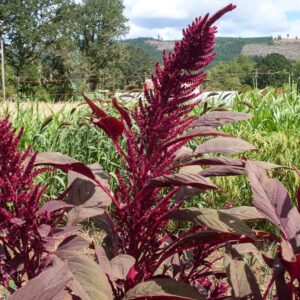 Introduction: What Is Amaranth?
Introduction: What Is Amaranth?
Tucked away in the valleys of the Himalayas grows a tiny grain with an ancient legacy and a remarkable nutritional profile—Amaranth. Although commonly categorized among millets, Amaranth is botanically different. It’s a pseudo-millet, meaning it shares characteristics with grains but belongs to a different plant family—closer to spinach than to traditional grasses.
Despite its modest appearance, Amaranth has been a staple in various indigenous diets for centuries. In the Himalayan region, it’s cherished not only as food but also as a functional ingredient in health and wellness rituals. Its naturally high nutrient density, coupled with medicinal qualities, has earned Amaranth recognition as a superfood in contemporary nutrition.
In this blog, we explore the origin, health benefits, uses, and scientific reasoning behind why Amaranth is gaining global popularity—particularly among women, vegetarians, and health-conscious eaters.
The Origins and Botanical Identity of Amaranth
Unlike traditional millets such as pearl millet or foxtail millet, Amaranth does not belong to the grass family. Instead, it’s a broadleaf plant native to South America and the Indian subcontinent. In India, particularly the Himalayan belt and parts of Madhya Pradesh, Amaranth grows abundantly—like a dense, carpet-like layer across mountain slopes.
Due to its similar nutritional benefits and culinary uses, it’s commonly grouped with true millets. However, from a botanical point of view, it is more accurately described as a pseudo-cereal, much like quinoa or buckwheat.
What truly sets Amaranth apart, though, is not just its resilience or yield, but its comprehensive nutritional content and functional properties.
Top Health Benefits of Amaranth
1. An Iron-Rich Natural Remedy
Amaranth is a time-tested remedy for iron deficiency. In Himalayan households, women often consume Amaranth Kheer during pregnancy as a natural alternative to iron supplements. Rich in non-heme iron, Amaranth helps in the production of red blood cells, thus preventing anemia and promoting better oxygen transport in the body.
Iron plays a vital role in energy levels, muscle function, and immune strength. For menstruating women, adolescents, and pregnant mothers, this grain offers a plant-based iron source without the side effects of synthetic supplements.
2. A Natural Ally Against Premature Aging
Amaranth is rich in antioxidants, particularly vitamin E, phenolic acids, and flavonoids. These compounds combat oxidative stress, one of the primary causes of premature skin aging.
Women in the Himalayan regions often attribute their skin’s natural elasticity to a regular diet that includes Amaranth. Today, extracts from Amaranth seeds and leaves are even used in cosmetic formulations, targeting wrinkles, age spots, and inflammation.
Scientific research also highlights squalene, a compound found in Amaranth oil, which nourishes the skin and supports cellular regeneration. This makes Amaranth not just a health food, but a beauty enhancer as well.
3. A Rare Source of Complete Plant Protein
Amaranth is one of the very few plant sources that contain all nine essential amino acids, making it a complete protein. This is particularly valuable for vegetarians, vegans, and people reducing animal protein intake.
The high lysine content, an amino acid typically low in grains, improves protein utilization and supports muscle development, tissue repair, and enzyme function.
A 100-gram serving of uncooked Amaranth provides approximately 13–15 grams of protein, making it an ideal ingredient in high-protein diets, especially for growing children, athletes, and those recovering from illness.
4. Gluten-Free and Gut-Friendly
Amaranth is naturally gluten-free, making it suitable for individuals with celiac disease or gluten intolerance. Unlike wheat or barley, Amaranth is gentle on the digestive system and promotes better nutrient absorption.
Its high dietary fiber content supports gut health, regulates bowel movements, and contributes to satiety—helpful for those managing weight or metabolic health.
Traditional and Modern Culinary Uses of Amaranth
Amaranth is as versatile as it is nutritious. It can be incorporated into a variety of dishes in both traditional and modern kitchens.
Traditional Recipes:
Amaranth Kheer: A classic pudding prepared with boiled Amaranth seeds, milk (or plant-based alternatives), jaggery, and cardamom. A favorite during fasting or pregnancy.
Rajgira Roti or Puri: In many parts of India, Amaranth flour is used to make flatbreads during fasting periods (vrat).
Laddus and Sweets: Amaranth seeds are often roasted and mixed with jaggery to make wholesome energy balls.
Modern Innovations:
Amaranth Porridge: A hearty breakfast bowl with fruits, nuts, and plant milk.
Baked Goods: Amaranth flour can be mixed with other flours to bake gluten-free muffins, pancakes, or cookies.
Salads and Soups: Cooked Amaranth can be added to soups or tossed into grain bowls and salads.
Popped Amaranth: A crunchy, popcorn-like snack or topping for yogurts and smoothie bowls.
Scientific Backing and Nutrient Profile
A closer look at Amaranth’s nutrient composition reveals its status as a nutritional powerhouse:
Nutrient (per 100g, uncooked) Approx. Value
Protein 13–15 g
Iron 7.6 mg
Calcium 159 mg
Fiber 6.7 g
Magnesium 248 mg
Potassium 508 mg
Vitamin B6 0.6 mg
Antioxidants (flavonoids, squalene, phenolic acids) High concentration
These nutrients contribute to bone health, immune function, skin integrity, and metabolic balance.
Conclusion: Embrace the Legacy of Amaranth
Amaranth is more than a pseudo-grain—it’s a symbol of ancient wisdom meeting modern nutrition. With its rich iron content, anti-aging benefits, complete protein profile, and gluten-free nature, Amaranth is a gift from nature that suits every modern diet.
Whether you’re looking for a functional food to support wellness, a vegetarian protein boost, or simply a natural addition to your skin-health routine, Amaranth is a worthy addition to your pantry.
As the world turns its attention back to traditional, earth-grown foods, this ancient Himalayan treasure is finally getting the spotlight it deserves.
